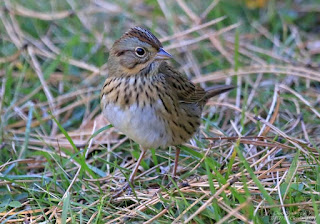Fall birding brings excitement and frustration
 |
| This furtive Nelson's sparrow appeared on the Wake Robin Trail, Mentor Marsh/Jerry Talkington |
Northeast Ohio's lakefront habitats provide best Fall birding opportunities
Two alliterative words best describe the theme for Fall birding in Northeast Ohio: Furtive and Frustrating.
 |
| Orange-crowned warbler in goldenrod/Chuck Slusarczyk Jr. |
As
many as 40 percent won’t survive the roundtrip journey. Thousands
are killed every year by collisions with windows at downtown
buildings. Fortunately, several hundred stunned birds are rescued by
the amazing volunteers of the Lights Out Cleveland group.
The
best birding in the area can be found in the vicinity of Lake Erie
such as the Cleveland Lakefront Nature Preserve, Headlands Beach
State Park, Mentor Marsh Preserve, Wendy Park, the Lorain
Impoundment, and the Sandy Ridge Reservation in North Ridgeville.
 |
| Lincoln's sparrow/Chuck Slusarczyk Jr. |
So
many birds flitting about, providing a constant whirl of motion in
our peripheral vision, but many escaping detection. Multitudes of
songbirds move through the foliage, feeding, chasing each other, and
hiding to avoid detection from predators. They produce a blur of
activity that I find frustrating in my attempts to focus, identify
and admire every bird – an almost impossible pursuit.
Don’t
get me wrong, I love fall birding. It provides excitement second only
to that of the spring migration. But in contrast to the spring birds,
sporting their bright and colorful breeding plumages, many of the
fall migrants are duller and look-alikes, dressed in various shades
of green, brown or gray, further contributing to the difficulty of
identification.
 |
| Yellow-rumped warbler, fall plumage/Joan Scharf |
Gradually,
thrush appear, primarily Swainson’s and gray-cheeked. Warblers fill
the trees: bay-breasted, Tennessee, black-and-white, black-throated
green, Blackburnian, Cape May, blackpoll, magnolia, pine, Wilson’s,
and American redstart, plus red-eyed, warbling and Philadelphia
vireos.
Recently,
the warblers have been joined by multitudes of yellow-rumps, and
lesser numbers of Nashville, Northern parula, chestnut-sided,
black-throated blue, palms and, especially in the goldenrod at the
Lakefront Nature Preserve, orange-crowned.
 |
| Swamp sparrow/Jerry Talkington |
Waves
of blue jays and white-throated sparrows have begun to arrive, with
lesser numbers of white-crowned, Lincoln’s and swamp sparrows.
Lucky birders will spot a Nelson’s or LeConte’s sparrow at the
Mentor Marsh, Lorain Impoundment or the Lakefront Nature Preserve.
Soon, most of these species will be supplanted by dark-eyed juncoes,
fox and American tree sparrows.
Beginning
next month, the lakefront and nearby inland lakes will be inundated
by waterfowl: ducks, geese, grebes, and loons. Reports of jaegers on
Lake Erie will spark excited birders to lug their spotting scopes to
beach overlooks for the opportunity to witness these pelagic
marauders as they harass gulls.
The
telltale calls of migrating flocks of tundra swans passing overhead
on their journey to the East Coast is a thrilling sound not easily
forgotten.



Comments
Post a Comment